Review | The Eternal Present Continuous: The 2025 Beijing Modern Music Festival Successfully Concludes
As sound rent the Beijing night sky, myriad images surged like a nascent tide. The music ceased, the galaxy swelled, and a chorus of tides echoed across the seas. In the blink of an eye, the Beijing Modern Music Festival has journeyed through twenty-two years. On the evening of May 20th, the 2025 Beijing Modern Music Festival concluded successfully with the Harbin Symphony Orchestra conducted by Wu Huaishi.
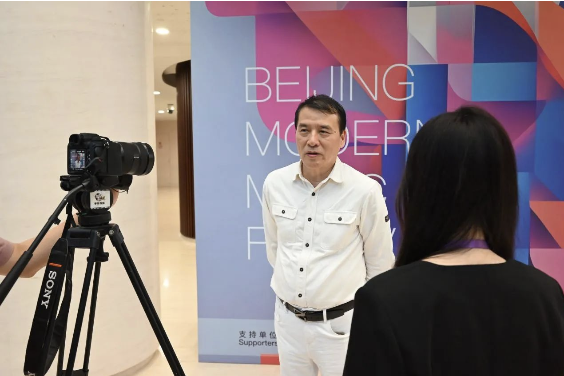
Under the helm of Artistic Director Professor Xiaogang YE, this year's six-day festival, a highly influential contemporary music event, brought together over a hundred musicians from around the globe. Through eleven concerts, one seminar, and three lectures/masterclasses, it showcased the vibrant vitality of Chinese modern music, built a bridge for dialogue between Eastern and Western civilizations, redefined the boundaries of modern music, and became a focal point for the global music community.
The Harbin Symphony Orchestra, performing at the closing ceremony, demonstrated masterful control and flexibility under the baton of Wu Huaishi. The "HSO" is a shining cultural emblem of Harbin, the "City of Music," having performed jointly with renowned orchestras such as the Berlin Symphony Orchestra of Germany and the Israel Philharmonic Orchestra. Serving as a friendly envoy for cultural exchange, under the leadership of Director Nie Bing, the HSO tells China's stories and showcases its image through music, earning widespread acclaim from audiences at home and abroad.
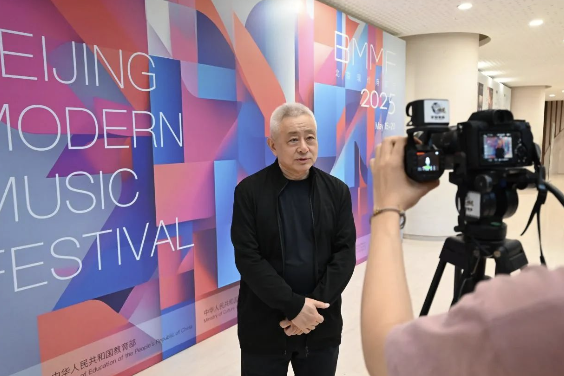
In the closing performance, this musical powerhouse from the "Ice City" enveloped the coldness of bronze with the tenderness of strings, and uplifted the elegance of silk with the brilliance of brass, allowing the imprints of Yinshan rock paintings and modern acoustics to resonate in the same soundscape. Through its century-long history, the HSO has proven that true artistic inheritance is not mere nostalgic imitation, but rather allowing ancient embers to burst forth with new light in contemporary scales. That night, they played not just music, but a cultural declaration written by a nation in symphonic form, engraving a new landmark in the long river of human culture.
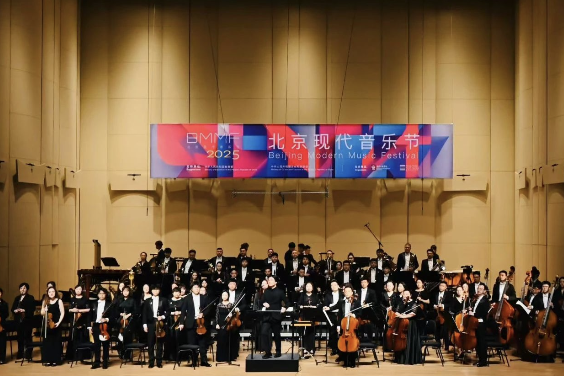
Closing Concert Featured Seven Masterpieces by Chinese and International Composers, Each Unique and Splendid
Symphony in the Clouds: A Civilizational Ode Amidst Skyscrapers
Zhou Xianglin's 《申城之巅》 (Pinnacle of Shencheng) used notes as a brush to sketch Shanghai's skyline in the void. This opening piece of the 2025 Beijing Modern Music Festival's closing ceremony was a profound inquiry into the future of civilization. Within an open and inclusive harmonic texture, steel and concrete transformed into growth rings, and glass curtain walls reflected the brilliant starry river of human civilization.
The music awakened from a hazy string background, with harp and percussion weaving the gentle lines of the EFGC four-note motive, like the first light of dawn breaking through the sky. As trumpets pierced the clouds with metallic melodies, the tidal pulse of percussion evoking the Huangpu River and the sprawling string melodies resembling the Bund's architecture formed a spatiotemporal dialogue. The composer, with precise polyphonic techniques, allowed the cello section's original motive to layer like a city's foundation, with violas and violins ascending sequentially, finally reaching a peak with a tutti of winds. As the same motive underwent instrumental transformation, the audience experienced not only the physical height of landmarks but also the eternal posture of a civilization extending towards the stars and seas through inclusivity and innovation.
In the finale, the trumpets achieved a final transcendence with open harmonies, the silence echoing with an unfinished query: as the torrent of modernity sweeps humanity forward, can music become a compass to anchor the coordinates of civilization? Zhou Xianglin offered a poetic response with this work.
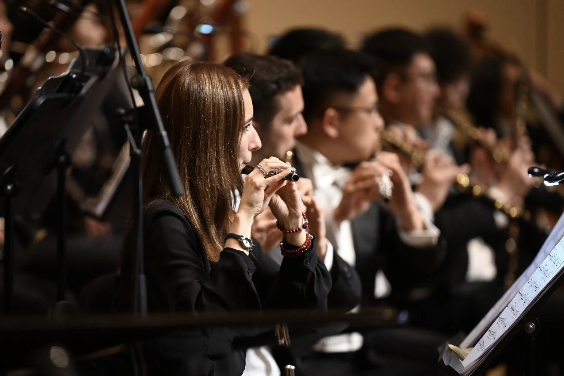
Dawn in the Underworld: Eternal Nirvana in Mythology
Matthias Pintscher's 《致奥西里斯》 (To Osiris) reconstructed, through music, the profound allegory of life, death, and rebirth from Egyptian mythology. Through precise instrumentation and symbolic motifs, it transformed the core themes of the Osiris myth – destruction, reassembly, and eternity – into an auditory epic.
The music's development followed a philosophical trajectory of wholeness-fragmentation-reassembly-transformation: dissonant effects created by percussion, winds, and violins playing sul ponticello symbolized the spread of death; fragmented timbres and instrumentation filled the middle section. At the climax, wind tremolos alternating in dynamics simulated divine struggle. Finally, through timbral transitions in different percussion instruments, the violins slid from solid tones to sul ponticello, concluding the piece with an ethereal resonance, suggesting the soul's eternal freedom beyond the physical body.
This work revealed music's profound metaphor: true immortality lies not in physical integrity, but in the eternal freedom the soul gains through fragmentation and reassembly. Destruction and rebirth are, by nature, art's eternal twin deities.

Mysteries of Mountains and Rivers: Civilizational Codes in a Long Scroll
The first movement, 《北海经》 (Classic of the Northern Seas), from Zhou Long's orchestral concerto 《山海经》 (Classic of Mountains and Seas), interwove the melodiousness of Mongolian long-tune with the passion of Tibetan xianzi (a string instrument), injecting the lifeblood of modern orchestral music into a primordial epic.
The music emerged from a dialogue between low tuba and high-register piccolo – the former as heavy as rock strata, the latter breaking through time and space with a Mongolian long-tune melody. Upon a vast backdrop paved by the repeated tremolos of cellos and double basses, the piccolo, oboe, and violins successively took up the stirring tones of the Tibetan xianzi. The work's climax formed a triple narrative dimension: timpani simulated the texture of wind-eroded petroglyphs, the string section outlined the expansive breath of the grasslands, and the winds became an ode to heroic epics. Even amidst the majestic roar of the full orchestra, a sustained note from the high-register piccolo, crescendoing from pianissimo for a full minute, pierced through the dust of history like a circling falcon.
When modern compositional techniques are infused into the primordial lifeblood of the 《山海经》, those civilizational genes engraved in petroglyphs and epics are ultimately reborn in the roar of the orchestra. Myth sheds its mysterious cloak, revealing the most authentic spiritual totem of the Chinese nation – reverence for mountains and rivers, praise for heroes, and a profound gaze upon all things in heaven and earth.
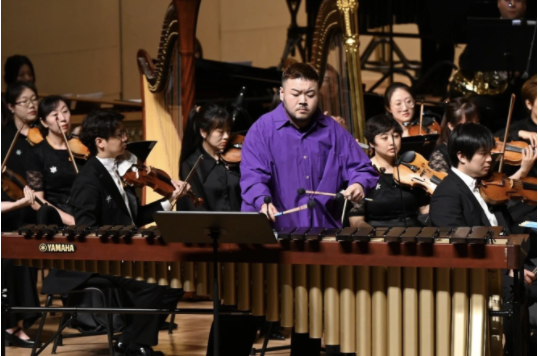
Crane's Cry to the Nine Heavens: A Modern Echo of Lingnan Spirit
When the marimba solo of Xiaogang YE's 《湾区鹤鸣》 (Crane Call in the Bay Area) sounded, the concert hall instantly transformed into a mystical mudflat amidst mangrove forests. This instrument, often hailed as the "harp of percussion," erupted under the composer's pen with the ardour of Lingnan's kapok flowers and the surge of the Pearl River tides. Xiaogang YE has used the marimba in the orchestration of many symphonic works, once stating: "The marimba can not only carry a joyful and uplifting charm but also express profound philosophical thoughts." The work's opening immediately revealed his deep insight into the marimba's timbre: its tidal rhythms formed an exquisite counterpoint with melodies characteristic of China's Lingnan region, achieving harmonious unity through their interplay.
Marimbist Yu Le's performance was exemplary; his expansive body language and precise timbral control made every strike a tangible expression of cultural lineage. The piece's coda elevated the music to a philosophical plane: winds, percussion, and marimba interwove in a marching rhythm, culminating in the marimba's torrential rapid strikes, where the melody, like a Peng bird, soared straight to the clouds, presenting a spirit both passionate and playful.
As Yu Le sketched the crane's cry with four-mallet technique, we seemed to see cranes from the scrolls of Southern Song dynasty painters break free and dance gracefully in the morning mist of Shenzhen Bay. This work innovatively captured the spiritual totem of Chinese literati through music, not merely imitating natural sounds but also perpetuating a millennia-old cultural vein.
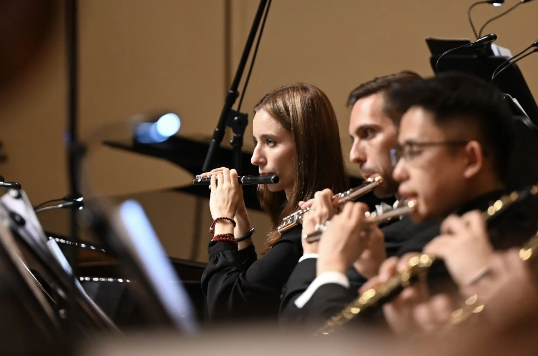
Eternal Rapids: A Cyclical Epic of Eden
David Ludwig's new orchestral work 《罗格河奔流》 (Rogue River Flowing), inspired by the Rogue River in the Pacific Northwest, recreated in the concert hall the ecological poetics of what the original text referred to as James Joyce's "eternal Eden."
Through precise instrumentation and cyclical structure, the work transformed nature's endless renewal into an auditory epic: the entire piece was built upon a cyclical motive of strings playing rapid up and down bows. Percussion subtly laid a spatiotemporal foundation in hushed tones, while long string melodies simulated the majestic, winding course of the Rogue Valley's river. The finale pushed the cyclical motive to its extreme – winds played continuously ascending scales over the strings' recurring theme, until the full orchestra suddenly faded at the peak, leaving only the cello to sustain the eternal echo with a final note.
When the last note vanished, what lingered in the concert hall was not merely a depiction of nature, but the profound covenant between humanity and nature: to endure in cycles, to be reborn in fragmentation. This "Möbius strip"-like narrative logic is not only a geographical cycle but also a metaphor for civilization's eternal continuation through destruction and rebirth.
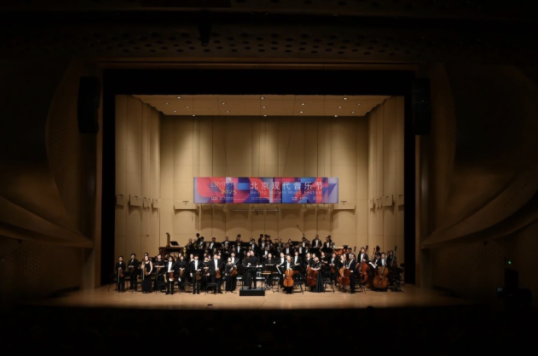
Nursery Rhyme Echoes: Cultural Memories in a Time Machine
Chen Yi's 《儿童组曲》 (Children's Suite) used the vibrant colors of the orchestra as a canvas to deconstruct and reassemble the genes of Chinese folk music, forging a "musical time machine" that transcends time and space.
The first movement, 《对歌》 (Antiphonal Singing), opened with a processional rhythm in the winds and percussion, the full orchestra's rapid flow of notes simulating an antiphonal singing ritual in the mountains of Yunnan. The oboe and flute, like children, tossed the melody of 《猜调》 (Guessing Tune) back and forth, while the piccolo and clarinet wove a polyphonic tapestry of a children's chorus. Chen Yi transformed the melodic forms of Yunnan children's antiphonal singing into a modern orchestral dialogue through "melodic relay" between instruments.
The second movement, 《北调》 (Northern Tunes), drew from Northern Chinese storytelling music and its characteristic structural variations, performed by the string section using an "instrumental vocalization" technique. Cellos and violas sketched the narrative with playful long melodies, while the violins' short glissandi vividly imitated the ornamental appoggiaturas of human singing. This movement was a veritable "storytelling session on strings," giving new life to the rhythms of folk art on the fingerboard.
The third movement, 《南舞》 (Southern Dance), inspired by Hainan's 《竹竿舞》 (Bamboo Pole Dance), transformed into a jubilant celebration for the full orchestra. The bassoon and piccolo used leaping notes to simulate dancers' steps, while the pizzicato of cellos and double basses precisely recreated the crisp sound of colliding bamboo poles, and orchestral accents marked moments like dancers leaping into the air. Through timbral imitation and rhythmic reconstruction, Chen Yi translated the dynamic imagery of ethnic dance into a three-dimensional musical theatre.
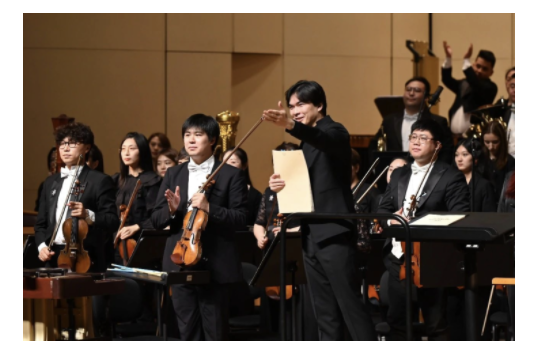
River of Civilization: A Millennial Moment in a Flying Apsara's Sleeve
Three excerpts from Guo Wenjing's ballet 《敦煌》 (Dunhuang) instantly transformed the concert hall into a lotus-adorned caisson ceiling of the Mogao Caves. As the music began, millennia-old frescoes flowed in the air – music has never been an artistic relic in a cave, but a breathing civilization, still vibrant after traversing deserts.
In the first excerpt, 美音鸟 (Kalaviṅka bird), the composer instrumentally imitated the most spiritual beings in Dunhuang murals: the clear calls of high woodwinds opened the theme. Amidst string melodies flowing like the ribbons of flying Apsaras, the crystalline harmonics of the harp reflected the shimmering light from murals in Caves 148, 172, and 237, as if the Kalaviṅka bird took flight from the paintings, its song entwined with the Milky Way.
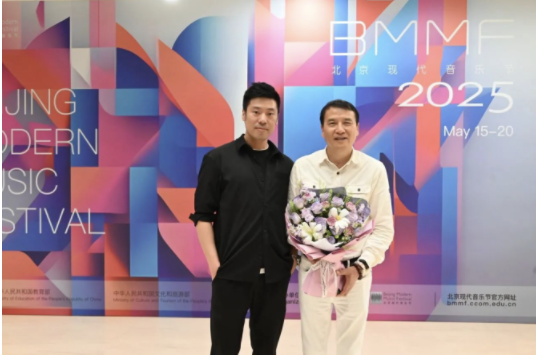
In the second excerpt, 飞天群舞 (Group Dance of Apsaras), a mysterious six-note motive, formed by upper and lower semitones, flickered in the timpani and low strings, constructing the spatiotemporal folds of the grottoes' depths. A violin solo used glissandi to outline the Apsaras' robes, while a dialogue between strings and clarinet gradually introduced more parts, until the full orchestra roared, pushing the Apsaras into three-dimensional space. When the harp, flute, and oboe alternated in solos, the music transformed into Apsaras of different forms, dancing inside and outside the murals, finally concluding with pizzicato from the cellos and double basses, like painted bodies returning to the silence of the stone walls.
In the third excerpt, 胡旋舞 (Whirling Dance), harp harmonics rippled like Crescent Lake. The compound rhythms of hand drums and tambourines instantly ignited the desert winds of the Western Regions. All violin and viola players held their instruments horizontally, simulating pipa plucking. Timpani and tambourines chased each other with extremely fast figures, recreating the afterimages of whirling dancers from Cave 220. When the orchestra fell silent abruptly from a fortissimo, the audience realized: that ecstatic whirling revelry from the High Tang Dynasty had never truly stopped.
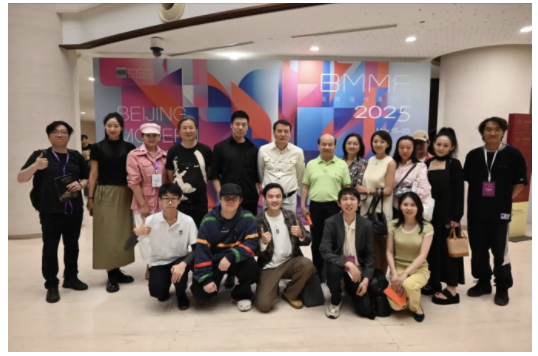
Guo Wenjing proved with his music: Dunhuang is not a historical specimen, but a living embodiment of civilizational genes. Those notes leaping across the score will eventually break through the walls and be reborn at some point in time and space, allowing the Apsaras' ribbons to forever flutter in the firmament of the human spirit.
With this, the 2025 Beijing Modern Music Festival came to a successful conclusion. This concert was not merely a presentation of seven works, but a meticulously designed dialogue of civilizations. From Shanghai's skyline to Dunhuang's caves, from the Nile's underworld to the Rogue River's Eden, composers used music as a vessel, carrying us through the mists of time and space. True modern music never rejects tradition; it simply, with a more open stance, invites the spirits of all eras to dance together.
The Beijing Modern Music Festival not only left audiences with indelible artistic memories but also declared to the world with an open and inclusive attitude: Beijing, an ancient yet modern city, is using music as its pen to write a magnificent chapter for this era in the long scroll of human civilization. This closing ceremony was both an end and a beginning – it let the world hear the formidable power of Chinese musical innovation, and more so, it let the future hear this present moment, transcending national borders and generations, playing a soulful symphony for all humanity.
Executive Director | Guo Hai'ou
Executive Assistants | Zhang Shuhao, Yin Nan
Text by | Xu Yaqi
Photography by | Zhang Yaxuan
